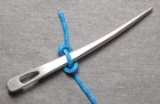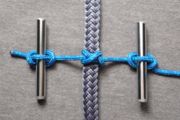
Marlinespike hitch
Encyclopedia
The marlinespike hitch is a temporary knot
used to attach a rod
to a rope
in order to form a handle
. This allows more tension
than could be produced comfortably by gripping the rope with the hand
s alone. It is useful when tightening knots and for other purposes in ropework
.
As the name suggests, the type of rod traditionally used with this hitch is a marlinespike. The advantages of this hitch over others which might serve the purpose are its quickness of tying and ease of releasing. Topologically it is a form of the noose
, but in practice this hitch is not allowed to collapse into that shape. When it does capsize into a traditional noose it can jam against the rod, making it much more difficult to release.
 Begin with an overhand loop. That is, a loop which the working part passes over the standing part.
Begin with an overhand loop. That is, a loop which the working part passes over the standing part.
Fold the loop over the working part, towards the standing part such that the standing part is visible through the center of the loop. In stiffer material the first two steps can be accomplished in a single motion by twisting the working part with the fingers until a loop forms and flops over the standing part.

Use the rod to snag a bight
of the standing part through the loop. That is, pass the rod over the near side of the loop, under the standing part and then over the far side of the loop.
Before tensioning, excess slack can be removed by pulling simultaneously on both the working and standing parts. In actual use the hitch should be loaded only from the standing side.
If the working end is loaded rather than the standing part, the knot will capsize into an overhand noose. While this form may still hold when the standing part is subsequently loaded, it can jam badly against the rod. This is especially troublesome if the rod is not tapered.
Knot
A knot is a method of fastening or securing linear material such as rope by tying or interweaving. It may consist of a length of one or several segments of rope, string, webbing, twine, strap, or even chain interwoven such that the line can bind to itself or to some other object—the "load"...
used to attach a rod
Rod (geometry)
In geometry, a rod is a three-dimensional, solid cylinder....
to a rope
Rope
A rope is a length of fibres, twisted or braided together to improve strength for pulling and connecting. It has tensile strength but is too flexible to provide compressive strength...
in order to form a handle
Handle (grip)
A handle is a part of, or attachment to, an object that can be moved or used by hand. The design of each type of handle involves substantial ergonomic issues, even where these are dealt with intuitively or by following tradition...
. This allows more tension
Tension (mechanics)
In physics, tension is the magnitude of the pulling force exerted by a string, cable, chain, or similar object on another object. It is the opposite of compression. As tension is the magnitude of a force, it is measured in newtons and is always measured parallel to the string on which it applies...
than could be produced comfortably by gripping the rope with the hand
Hand
A hand is a prehensile, multi-fingered extremity located at the end of an arm or forelimb of primates such as humans, chimpanzees, monkeys, and lemurs...
s alone. It is useful when tightening knots and for other purposes in ropework
Ropework
Ropework or Marlinespike Seamanship is the set of processes and skills used to make, repair, and use rope. This includes tying knots, splicing, making lashings, and proper use and storage of rope...
.
As the name suggests, the type of rod traditionally used with this hitch is a marlinespike. The advantages of this hitch over others which might serve the purpose are its quickness of tying and ease of releasing. Topologically it is a form of the noose
Noose
A noose is a loop at the end of a rope in which the knot slides to make the loop collapsible. Knots used for making nooses include the running bowline, the tarbuck knot, and the slip knot.-Use in hanging:...
, but in practice this hitch is not allowed to collapse into that shape. When it does capsize into a traditional noose it can jam against the rod, making it much more difficult to release.

Fold the loop over the working part, towards the standing part such that the standing part is visible through the center of the loop. In stiffer material the first two steps can be accomplished in a single motion by twisting the working part with the fingers until a loop forms and flops over the standing part.

Use the rod to snag a bight
Bight (knot)
In knot tying, a bight is a curved section, slack part, or loop between the two ends of a rope, string, or yarn. The term is also used in a more specific way when describing Turk's head knots, indicating how many repetitions of braiding are made in the circuit of a given knot.-Slipped knot:In order...
of the standing part through the loop. That is, pass the rod over the near side of the loop, under the standing part and then over the far side of the loop.
Before tensioning, excess slack can be removed by pulling simultaneously on both the working and standing parts. In actual use the hitch should be loaded only from the standing side.
Undesirable capsized form
If the working end is loaded rather than the standing part, the knot will capsize into an overhand noose. While this form may still hold when the standing part is subsequently loaded, it can jam badly against the rod. This is especially troublesome if the rod is not tapered.

